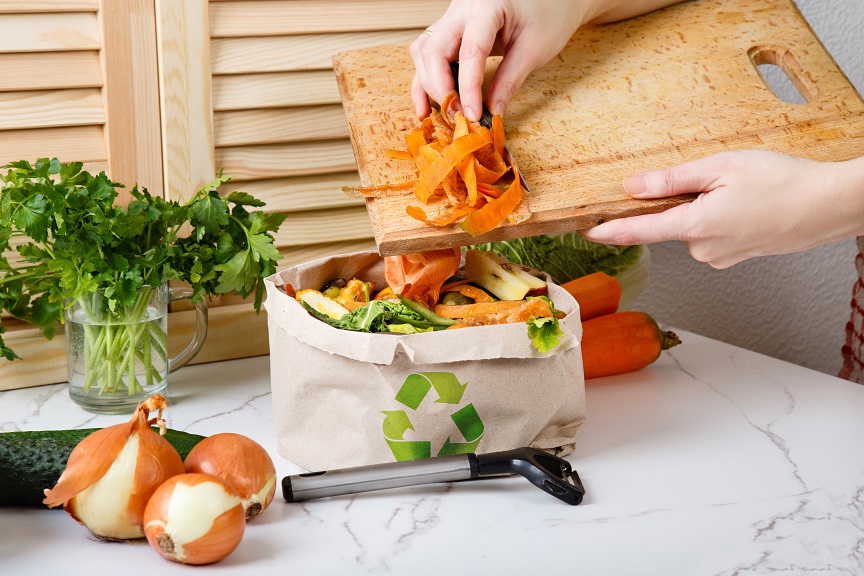

We have all done it. You bring lunch to the office, but then plans change, and instead, you go out for lunch with your colleagues, dooming your home-prepared meal to become another suspicious substance in the office fridge.
Food waste is a serious problem. With greenhouse emissions produced by food waste threatening the health of the planet’s population, and about 821 million people globally living with less food they need daily, the consequences of wasting what food we’ve produced are real and devastating.
Finding solutions to food waste even on the smallest scales can help alleviate part of the burden and prompt more to join in finding sustainable, kind, and thoughtful solutions to this issue.
So let’s look at how your business can turn into a place for positive change and in return help you reach more with the excellent work you do. First, some numbers.

According to the World Wildlife Foundation (WWF), about 10% of global greenhouse emissions come from food waste. In a research conducted by the WWF and Tesco, approximately 1.2 billion tons of food is lost on farms, in addition to the 931 million tons of food waste retail and consumption sectors account for.
That’s not it though. Food waste results in the loss of valuable resources, like water, land, energy, labor, and capital. Food losses cost us roughly $680B in industrialized countries and $310B in developing countries.
1 in 6 people in the United States are food insecure or do not have enough affordable, nutritious food. It’s paradoxical, that at the same time, between 30% and 40% of the food produced in the States is thrown away.
All the resources we invest in producing our food seem wasted. In the U.S., it takes about 1000 gallons of water to produce 1 pound of beef. Calculations show that up to 25% of the water we use in agriculture goes to waste. Add the fossil fuel used by farmers for operating equipment and there you have an exacerbated environmental issue.
Food trash also has a significant financial impact. The United States Department of Agriculture (USDA) estimated that in the US we lose about $161B in food waste annually. The estimation includes the price of food, costs of labor, land, water, and all other resources involved in food production.
Lastly, food trash influences us socially. The lack of proper nutrition is an issue that affects people not only in developing countries but here in the United States. Food scarcity raises vital questions on sustainable food production and distribution that we all as global citizens should be aware of, and contribute to.

As a company owner, you and your team are in a great position to raise awareness of the food waste issues and apply practical solutions toward limiting waste from going to waste.
You can set up educational programs, and recycling policies, you can take part in community recycling programs, organize industry events to look for new ideas and share knowledge on the subject, and of course promote the issue on social media. These tools will help you, your employees, and the industry community to reduce waste.
The first place where you can start your sustainable food scrap management is the office. Here are a few ideas on how you can reduce food waste at the workplace.
When you start with food waste management it’s important to remember that like every company policy it takes time to set proper food scrap management. It’s important to be proactive, this will help to keep the office clean, conscious, and free of pests.

The first thing you should do on your zero-food scrap journey is, evaluate your current situation. Look at when and where food waste accumulates, what is your organization currently doing about it, what can be done to improve food waste management, and what sustainability goals you want to pursue.
Once you know where your company stands, you can begin creating a plan that will help you break down these goals into actionable steps toward zero-waste food management.

Awareness is essential to your sustainable food scrap management plan. To be successful on the set goals you need to have the support of your staff. People should understand and willingly commit to cutting the food waste in the office.
To make sure, however, that everyone is aware of the collective goals you need to put the time and effort to educate and win the support of employees.
Raising awareness of the fact that about 40% of the food supply in the United States goes to waste, for example, might influence people’s choices in the office. They might consider more carefully what happens with their leftovers if they just get thrown away in the garbage bin.

Simply throwing food scraps in the trash is definitely a slippery slope that not only creates a smelly mess but can attract pests. There’s, however, a much better way to get rid of food waste and that’s composting.
Composting is not only a cleaner way to deal with food scraps like egg shells, veggie and fruit peels, and other organic food scraps, but is a full-circle solution to the problem of food waste. Through composting, you create fertile soil that can be used for growing more organic food.
How do you compost in the office?
There are two most common practices for office composting. You can either set up a compost bin in the office or work with a local composting company.
Composting can be one of your office recycling educational pillars. Helping people learn the answers to questions like “ What food scraps can be composted?” and “What to do with food scraps that can’t be turned into compost?” might urge them to try composting at home too.

There are plenty of ways to efficiently use food in the office. If your company has a cafeteria and serves food to employees then you might want to consider

One way to reduce food waste is to offer smaller portion sizes. This can be done by providing smaller plates or offering a lunch buffet where employees can choose their portion sizes.

Another way cafeterias can solve food waste issues is by incorporating leftovers into more meals. For instance, your chiefs can create new menus around unused ingredients left from previous meals.
They can even stress your food waste sustainability goals more by creating catchy and thought-provoking names for those meals. Words like “rescued veggie wrap”; “sustainable turkey sandwich” work great at pointing attention to what “food has to say”.

One more way to reduce food waste in the office is to encourage employees to take leftovers home. This can be done by providing storage containers or offering discounts on meals after a certain hour.
On Fridays, you can organize a kitchen clearance type of event where you either gift food or offer it at a big discount. This will stimulate people to help with using as much of the food ingredients you have left in the office. You can even further offer that food with recipe suggestions, so people wouldn’t have to wonder what to use it in.

If your resources for dealing with leftover food in the office are limited, you can think of donating whatever you have left to a local food bank or soup kitchen. This is a great way to help those in need and reduce food waste at the same time.

Organizing a team-leading the switch to a sustainable food system disposal in your office will guarantee that vigilant eyes are always looking if waste is properly taken care of.
This team will be tasked with disseminating educational information on what happens with our food in the States, how it affects the environment, and the well-being of countless ecosystems and people in vulnerable areas.
Your food waste team can also lead the set of processes of conscientious food disposal and teach others in the office how to follow suit.
But what will incentivize people most is creating a reward system for everyone willing to participate in the collective effort of decreasing food waste in the office.
Make sure that people get praised for their sustainable undertakings, welcome their ideas on improving the processes, and stimulate their continued participation by offering extra time off, bonuses, and other incentives that you can allow for.
Further organizing brainstorming sessions, team building outings center around sustainable food management, and special shoutouts to those who are extra achievers will help you cement the support of your office team.
Sustainability is an investment but it pays off multifold. Your sincere dedication to such an impactful environmental cause will create trust and brand ambassadors within and out of your company.

What is the best way to deal with leftover food? Use it again. Wasting perfectly good produce and leftover meals have gotten us into huge environmental, social, and economical troubles, and the sooner we find sustainable and safe solutions to this ever growing problem, the better.
It’s the time to deal with food waste and the place you can start tackling the issue is in the office.
It starts with the small steps of being mindful of the food your company offers to employees and continues with the education of as many people in and out of your organization as possible on how they can individually contribute to lessening the food waste burden.
Show your social engagement and people will appreciate your brand for more than the products or services you offer.